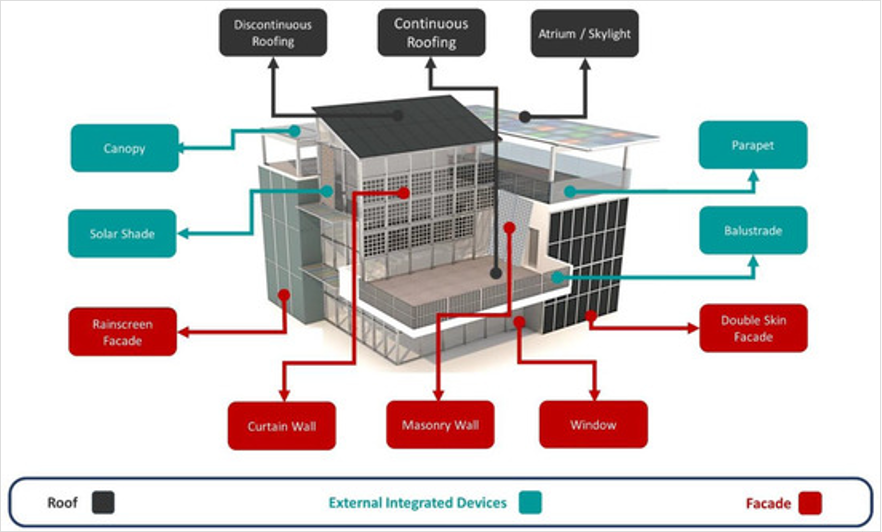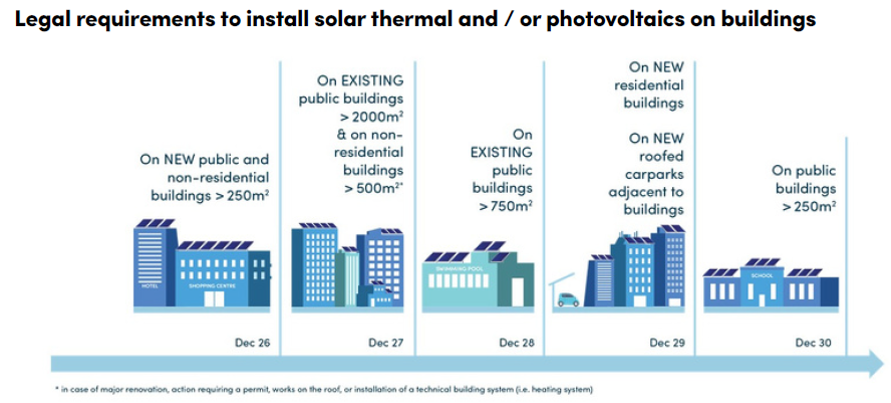
Maximising solar energy in buildings: Fostering deployment and skills

Maximising solar energy in buildings: Fostering deployment and skills
Explore how the integration of solar energy is reshaping European building stock and helping Europe reach net-zero emissions.
(Note: Opinions in the articles are of the authors only and do not necessarily reflect the opinion of the European Union)
Introduction
The shift to renewable energy sources (RES) is vital for reducing the carbon footprint and fostering energy independence. Solar energy is the fastest-growing RES, largely due to an 82% drop in costs between 2010 and 2020. Buildings can harness solar energy through passive methods (building orientation and design based on solar irradiance) and active systems such as photovoltaic (PV) panels and solar thermal technologies. Combining both approaches is key to maximising a building’s solar potential, as is the alignment of solar technology integration targets with those of a building's energy performance.
PV systems convert sunlight into electricity, while solar thermal systems help to meet heating and hot water needs. These are typically installed on rooftops, but newer solutions include Building-Integrated Photovoltaics (BIPV), where solar panels double as architectural elements like roof tiles or façades. Photovoltaic–Thermal (PVT) systems merge electricity and heat generation in one unit. Within PV systems, plug-in systems – including balcony PV – allow small-scale solar setups to connect directly to household power sockets. In fact, the revised Electricity Market Directive (EU/2019/944) allows Member States to promote the installation of such systems, including through network tariffs.
Solar energy integration in buildings offers several benefits: it contributes to reducing energy bills, improves energy efficiency, and enhances environmental performance. When paired with technologies like IoT and AI, solar systems can predict energy output and optimise performance. Widespread adoption also protects consumers from energy price fluctuations and helps combat energy poverty. However, challenges remain. Solar energy’s variable supply, low conversion efficiency, and the complexity of integrating systems into existing buildings pose technical hurdles. Economically, despite cost reductions and low operational costs, upfront investment remains relatively high compared to other energy sources. In addition, regulatory inconsistencies across EU Member States may hinder progress. For instance, while BIPV is not new, it remains a niche market in the EU, with a limited and specialised demand and just a handful of producers, largely due to different legal requirements and certification needs for such products and market fragmentation. Lastly, more skilled workers are needed to meet the EU renewable energy deployment targets, including in the solar sector.

Figure 1. Different ways of solar energy integration in buildings (Reddy, Hariram, Ghazali, & Kumarasamy, 2024).
EU policy framework
The Energy Performance of Buildings Directive in Article 10, mandates increased deployment of suitable solar energy installations on new buildings and certain existing non-residential buildings where technically and economically feasible. It ensures that new buildings are solar-ready, fitted to host solar installations based on site-specific solar irradiance, thus facilitating future installation of solar technologies without expensive modifications.

Figure 2. Legal requirements for installing solar thermal and/or PV systems on buildings (source: Solar Heat Europe).
Solar energy deployment on buildings is also supported by other articles in the EPBD: Article 3 mandates that National Building Renovation Plans should include an overview of policies and measures for solar energy installations, with the first draft due by 31 December 2025; Article 7 specifies that all new buildings shall be zero-emission buildings (ZEBs) by 2028 for public bodies and by 2030 for all new constructions. ZEBs are defined in Article 11, as buildings that do not cause on-site carbon emissions from fossil fuels. Their annual primary energy use shall be covered by renewable sources generated on-site or nearby, from renewable energy communities, efficient district heating and cooling systems, or other carbon-free sources where technically and economically feasible. Article 17 lays out a framework for providing administrative, technical, and financial support, enabling more efficient implementation of renewable technologies. To maximise the potential of solar installations, Member States should establish criteria for implementation, including exemptions, considering the technical and economic viability of solar technologies while maintaining technology neutrality and the combination with other uses such as green roofs.
The EPBD is complemented by the Energy Efficiency Directive (EU/2023/1791), aiming for an 11.7% reduction in energy consumption by 2030, and the Renewable Energy Directive (EU/2023/2413), which sets an indicative target for at least a 49% share of energy from renewable energy sources in the building sector by 2030. It also establishes in its Article 16d a maximum permit-granting procedure time for the installation of solar energy equipment, including building-integrated solar installations. In the case of installations with a capacity of 100 kW or less, it shall not exceed one month.
Some EU countries have established mandatory requirements for renewable energy sources (RES) in new buildings. For example, Spain’s Technical Building Code mandates that new buildings incorporate renewable energy, aiming to cover a specific percentage of energy needs with renewables. The Royal Decree 244/2019 defines the term ‘self-consumption’ and provides simplified procedures to legalise photovoltaic installations of 100 kW or less.
Similarly, Italy’s Energy Performance Regulation requires new buildings to meet energy efficiency standards, including the integration of renewable technologies. The Legislative Decree 28/2011 mandates that a portion of energy for new buildings comes from renewable sources, promoting the installation of PV systems.
Financial aspects
Article 10 of the EPBD mandates that Member States must ensure the deployment of suitable solar energy installations, with the associated costs typically included in the overall construction price, allowing for a simpler financial planning process. However, it is essential to take into account operational costs, which, while generally low, may include maintenance and repair expenses. As more buildings adopt solar energy, shifts in local energy markets may occur, potentially impacting electricity prices.
In contrast, existing buildings might face challenges in maximising solar energy use due to financing issues. Long-term savings on energy bills represent a critical financial benefit. By generating electricity on-site, buildings can reduce their dependence on the grid, leading to substantial cost savings, especially in regions with high energy prices.
To this end, Article 17 of the EPBD mandates that Member States must optimise the use of national and EU-level available funding, including the Recovery and Resilience Facility, the Social Climate Fund, and the Cohesion Fund, to mobilise investments. They shall promote the development and use of financial tools for building renovations, such as energy efficiency loans, green mortgages, energy performance contracting, and fiscal incentives, such as reduced tax rates on renovation materials. These financial products should be widely accessible and non-discriminatory, with banks and investors informed of opportunities to improve the energy performance of buildings. One-stop shops may assist citizens and professionals in accessing financing and support for both energy efficiency measures and solar energy.
In addition, business models such as energy communities can play a significant role in the deployment of solar energy, distributing costs and benefits more equitably. Innovative financing solutions such as cooperative ownership and community solar projects can provide pathways for existing buildings to harness solar energy without the burden of high upfront costs.
Initiatives and best practices
The European Commission has launched several initiatives under the EU Solar Energy Strategy to identify remaining barriers and challenges in the solar energy sector. The strategy outlines initiatives to promote solar technologies and accelerate their deployment, enhance energy efficiency, and attract investments in solar infrastructure, bolstering energy independence and supporting economic growth through renewable energy integration.
One key initiative is the European Solar Rooftops Initiative, designed to accelerate solar energy deployment on rooftops throughout the EU. This initiative aims to mobilise investments, streamline permitting processes, and increase public awareness about the benefits of solar installations, ultimately maximising the potential of rooftops for solar energy generation.
The EU Solar PV Industry Alliance is also a significant component of the strategy, emphasising the importance of building a resilient and competitive solar value chain within Europe. A notable development is the European Solar Charter, signed on April 15, 2024, by 23 EU Member States and over 100 solar companies. This voluntary pact aims to revitalise Europe’s solar manufacturing sector and reduce reliance on imports, particularly from China. The Charter’s core ambition is to create a sustainable and competitive solar value chain essential for achieving the EU’s climate and energy goals. Key measures include the swift implementation of the Net-Zero Industry Act to boost local clean technology production, reforms in public procurement to reward sustainability, and the mobilisation of EU funding for domestic solar manufacturing investments.
In addition, a sufficient number of trained professionals is necessary for effective energy renovations, and Member States must put in place measures and funding to promote education and training to ensure that there is a sufficient workforce with the appropriate level of skills corresponding to the needs in the building sector, particularly targeting small and medium-sized enterprises (SMEs). The EU Large-Scale Skills Partnership was launched in March 2023 following its announcement in the Solar Strategy, which addresses the skills gap in the renewable energy sector. By focusing on workforce development, this initiative aims to turn current workforce bottlenecks into opportunities for green jobs, thereby driving the clean energy transition. The European Solar Academy was launched in 2024, aiming to train 100,000 workers over three years.
The following innovative solar technology integration cases exemplify these initiatives, highlighting European countries’ commitment to solar energy and to promoting innovative technologies in building energy systems:
- Kara House in Sweden: This demonstration building showcases the potential of hybrid photovoltaic-thermal (PVT) collectors combined with ground-source heat pumps (GSHPs). These technologies support borehole temperature regeneration and improve seasonal performance, making heating and cooling more efficient and sustainable.
- Mira-sol Civic Centre in Sant Cugat del Vallès, Spain, is part of the EU-funded SunHorizon project. This facility combines high-vacuum solar thermal panels with a hybrid adsorption-compression chiller and advanced heat pumps to provide both space heating and cooling. The system is supported by thermal storage tanks and a sophisticated monitoring-and-control interface. The building’s performance is optimised through real-time data from sensors tracking temperature, humidity, CO₂ levels, and occupancy across ten rooms.
- Powerhouse Brattørkaia in Norway: it is a positive energy building, meaning it produces more energy than it consumes. It employs solar photovoltaic panels on both its façade and roof to harness solar energy effectively. Additionally, it integrates a heat pump system that utilises residual heat from the building and external air for both heating and cooling.
European projects
The implementation of solar energy on buildings is significantly supported by European research and innovation funding programmes:
Under the Horizon 2020 programme:
- POWER UP focuses on enhancing the integration of on-site renewable energy sources in new buildings, proposing solutions such as solar energy systems and smart energy management technologies to promote sustainability and energy efficiency. The project aims to make new buildings energy self-sufficient while aligning with regulatory frameworks.
- CLEAR-X engaged 38,000 consumers in collective purchase campaigns across six countries, facilitating access to renewable energy solutions and energy-efficient technologies helping to reduce energy bills and promote sustainable energy investments.
Under the current Horizon Europe framework:
- MASS-IPV advances the integration of PV technology into building structures, promoting multifunctional materials that generate solar energy and support the transition toward zero-energy buildings.
- SPHINX seeks to develop smart photovoltaic systems adaptable to varying environmental conditions, optimising energy production through innovative technologies and real-time monitoring.
- SKILL BILL is creating several pathways to motivate target groups to become interested and involved in RES, and to develop instruments for upskilling and reskilling, to tackle fake news on RES, owing to poor-quality information materials, the gender gap and functional illiteracy.
Other funding programmes like LIFE have also contributed to the implementation of solar energy:
- COOLSPACES 4 LIFE aims to increase the share of renewable energy and the optimisation of energy consumption in public building cooling systems by testing a prototype with a new CFR-based cooling subsystem powered by PV panels, and short-term cooling energy storage with phase change materials.
- LIFE BIPV demonstrated an innovative BIPV system designed for net-zero energy buildings, integrating PV technology into building materials while maintaining architectural aesthetics. Key results included effective real-world demonstrations, development of design guidelines, and stakeholder engagement to promote BIPV technology adoption.
- LIFE-LOOP supported the launch of Croatia's first citizen-owned solar power plant, ZEZ Sun, marking a significant step towards energy democracy. The installation of the 200-kW system located on the roof of the city market of Križevci not only generates financial returns but also contributes to local projects fighting energy poverty.
Conclusion
Solar is the fastest-growing source in the EU, yet there is untapped potential for its integration in buildings. As of 2023, the EU-27 reached a cumulative rooftop solar PV capacity of approximately 137 GW. However, solar thermal penetration is still modest, despite an installed thermal capacity near 41 GWth. The EU solar energy strategy sets the scene for massive deployment, acknowledging the role of solar energy in delivering a substantial part of buildings’ electricity and heat demand.
The Energy Performance of Buildings Directive sets a clear regulatory path forward, mandating solar readiness in new buildings and promoting integration in major renovations. Yet, the policy framework must be matched by robust financial support and technological innovation. EU-funded programmes such as Horizon Europe or LIFE are playing a pivotal role in this regard. Projects like POWER UP, MASS-IPV, and COOLSPACES 4 LIFE showcase scalable solutions for integrating photovoltaics and thermal systems into both new and existing building stock.
To overcome persistent challenges – such as space limitations, skilled labour shortages, and market fragmentation – a coordinated approach is essential. Success depends on replicable models, cross-sector collaboration, and strong alignment between EU policy, national implementation, and local innovation ecosystems.
References
Reddy, V. J., Hariram, N. P., Ghazali, M. F., & Kumarasamy, S. (2024). 'Pathway to Sustainability: An Overview of Renewable Energy Integration in Buildings'. Sustainability.

